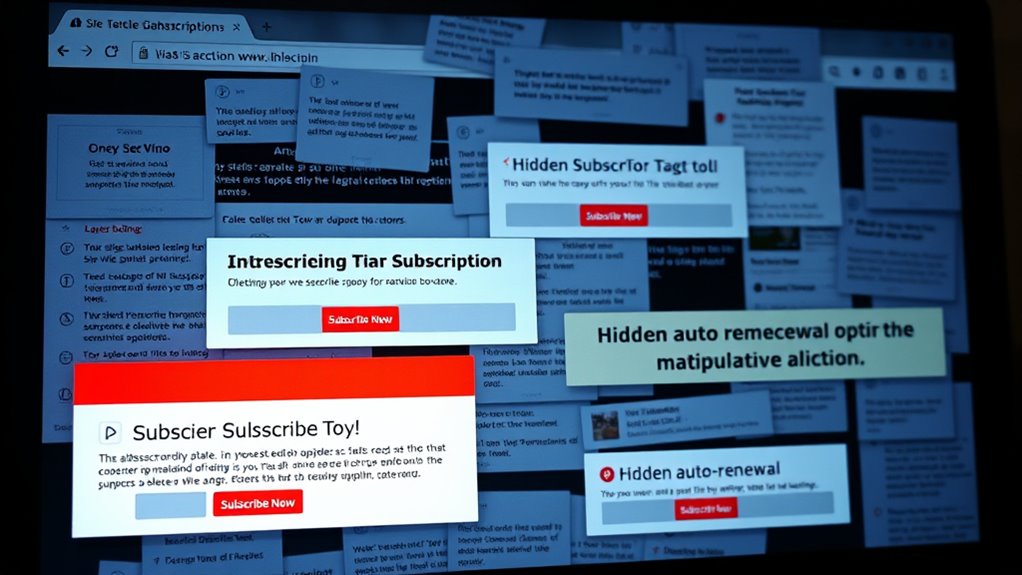To spot manipulative design, look for visual cues like bright colors that draw your attention or dull shades that hide options. Watch for tactics like countdown timers creating urgency or tricky “unsubscribe” links that hide important info. Be cautious with consent forms, ensuring they aren’t pushing emotional triggers or vague promises. Keeping an eye on hidden subscriptions and scrutinizing offers helps protect you. Stay alert—knowing these tricks reveals how to counter manipulation effectively. If you keep exploring, you’ll uncover even more ways to safeguard yourself.
Key Takeaways
- Recognize manipulative visual cues, like bright colors and subtle shades, that draw attention or downplay less desirable options.
- Question interfaces that hide information, create urgency with timers, or use emotional appeals to sway your decisions.
- Carefully read consent requests and fine print, avoiding emotional pressure or vague language designed to manipulate choices.
- Watch for hidden subscription traps by monitoring renewal notices, cancellation policies, and examining terms before signing up.
- Stay alert to psychological triggers, verify links and offers, and use privacy tools to protect against online deception.
Recognizing Common Types of Dark Patterns

Dark patterns are deliberately designed interfaces that manipulate users into making choices they might not otherwise make. One common tactic involves the use of visual cues to steer your attention or influence your decisions. Bright colors like red or orange often signal urgency or danger, prompting quick action without careful thought. Conversely, subtle shades can downplay less desirable options, making them less noticeable. Color psychology plays a key role in these manipulations, guiding your emotions and perceptions subconsciously. For example, a bright “Confirm” button might entice you to click without fully reading the details, while a duller “Cancel” option cleverly blends into the background. Recognizing how visual cues and color psychology work together helps you spot these tactics before they influence your choices. Additionally, understanding dark patterns can empower you to make more informed decisions online.
How to Identify Deceptive User Interface Tactics

To effectively identify deceptive user interface tactics, you need to pay close attention to how elements are presented and how they guide your decisions. Dark patterns often use psychological manipulation to influence your choices subtly. Look for designs that hide or obscure important information, such as tricky “unsubscribe” options or confusing cancellation buttons. Pay attention to color psychology—bright or contrasting colors may draw your eye to certain buttons or links, encouraging clicks you might not intend. Be cautious of countdown timers or limited-time offers that create urgency. Recognizing these tactics involves questioning whether the design’s goal is to help or manipulate you. Stay alert to patterns that exploit your instincts or emotions, and always consider if the interface’s layout serves your interests or secretly nudges you elsewhere. Additionally, understanding the role of color accuracy in user interfaces can help you better assess how visual cues are used to influence your perception and choices.
Strategies for Avoiding Manipulative Consent Requests

When encountering consent requests online, it’s important to approach them with skepticism and awareness. Recognize that many use psychological tricks and persuasive language to pressure you into agreeing. To avoid falling for manipulative tactics, read each request carefully and question its intent. Don’t feel compelled to accept all terms immediately; take your time to review what you’re agreeing to. Look for overly emotional appeals or vague language designed to sway you. Use browser extensions or privacy tools to block or manage unwanted cookies and pop-ups. Remember, you have the right to decline consent or customize your preferences. Staying informed and cautious helps you resist manipulative requests, empowering you to protect your online privacy and avoid falling prey to dark patterns. Additionally, understanding potential pitfalls in adopting new payment technologies can help you make more informed decisions when engaging with online services.
Tips for Navigating Hidden Subscription Traps

Hidden subscription traps often lurk behind seemingly free trials or low upfront costs, making it easy to overlook ongoing charges. To avoid falling for these scams, always pay attention to unsubscribe alerts, which indicate when a subscription is about to renew. Before signing up for a free trial, read the fine print carefully—many free trial traps automatically convert into paid plans if you don’t cancel in time. Set reminders to cancel before the trial ends if you don’t want the subscription to continue. Also, monitor your bank statements regularly for unexpected charges. When in doubt, check the company’s cancellation policy and contact customer service if you suspect any manipulation. Staying vigilant helps you avoid costly surprises hidden behind deceptive design. Additionally, understanding cookie management and privacy policies can help you recognize manipulative tactics used to collect data or influence your decisions.
Practical Steps to Protect Yourself From Online Deception

Protecting yourself from online deception requires staying alert and verifying the authenticity of digital interactions. Be aware of psychological triggers and behavioral nudges designed to manipulate your decisions. Always question unexpected messages or offers that pressure you to act quickly, as these are common tactics used in dark patterns. Take the time to research links before clicking, and don’t share personal information unless you’re sure of the source. Use strong, unique passwords and enable two-factor authentication to add layers of security. Stay informed about common manipulative tactics, and trust your instincts—if something feels off, it probably is. Additionally, implementing encryption solutions can help safeguard your data from unauthorized access and protect your privacy online. By remaining vigilant and questioning the motives behind online prompts, you can better defend yourself against deceptive designs.
Frequently Asked Questions
Are There Legal Regulations Against Dark Patterns?
You might wonder if there are legal regulations against dark patterns. Currently, legal enforcement varies, and many jurisdictions have regulatory gaps that make it tough to address manipulative design. Some countries are starting to introduce laws to protect consumers, but enforcement isn’t consistent worldwide. You should stay informed about regional rules, as stronger regulations could emerge, helping reduce the impact of dark patterns and hold companies accountable for deceptive practices.
How Do Companies Justify Using Manipulative Design?
Companies often justify using manipulative design by claiming it boosts engagement or sales, despite the ethical considerations around consumer manipulation. They argue that these tactics are justified by business goals or user convenience, even though such practices can deceive users. While some believe it’s a strategic choice, it’s essential to recognize the ethical implications and question whether prioritizing profit over consumer well-being truly benefits everyone involved.
Can Dark Patterns Be Effective in Ethical Marketing?
Think of dark patterns as siren songs—initially tempting, but ultimately misleading. While some may argue they boost short-term engagement, in ethical marketing, they risk sinking consumer trust and violating ethical considerations. True effectiveness lies in transparency and respect, fostering genuine connections. Using honest design builds loyalty and credibility, proving that authentic strategies outperform manipulative tactics in the long run. Dark patterns might deceive briefly, but ethical marketing wins hearts sustainably.
What Psychological Principles Do Dark Patterns Exploit?
Dark patterns exploit your cognitive biases and emotional triggers to manipulate your decisions. They often play on your tendency to follow social proof, feel urgency, or avoid loss, making you more likely to act against your best interests. By understanding these psychological principles, you can recognize when your emotions or biases are being manipulated, empowering you to make more informed, conscious choices rather than falling for deceptive design tactics.
How Can Small Businesses Avoid Employing Dark Patterns?
To avoid employing dark patterns, focus on building genuine user engagement and trust. Be transparent about your processes, clearly communicate options, and respect user choices. Don’t use manipulative tactics that pressure or deceive users into actions they wouldn’t otherwise take. Instead, prioritize honest interactions, which foster long-term loyalty and positive relationships. By doing so, your small business creates a trustworthy environment that encourages repeat engagement and sustains growth.
Conclusion
By staying vigilant and understanding dark patterns, you can outsmart manipulative designs. Don’t think you’re powerless—awareness is your best tool against online deception. Even if it feels overwhelming at first, practice spotting these tactics, and you’ll become more confident. Remember, you’re in control of your choices online. With a little effort, you can navigate digital spaces safely and confidently, avoiding traps and protecting your privacy every step of the way.









